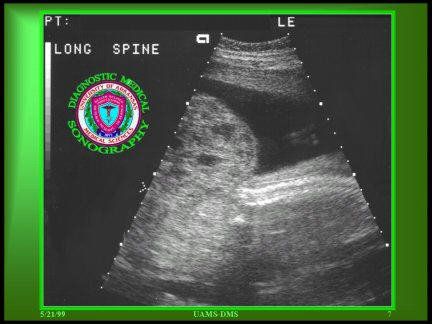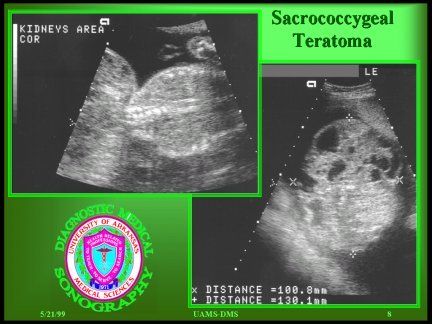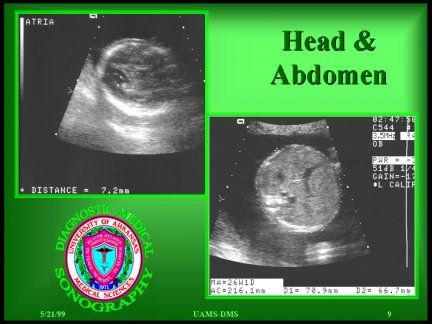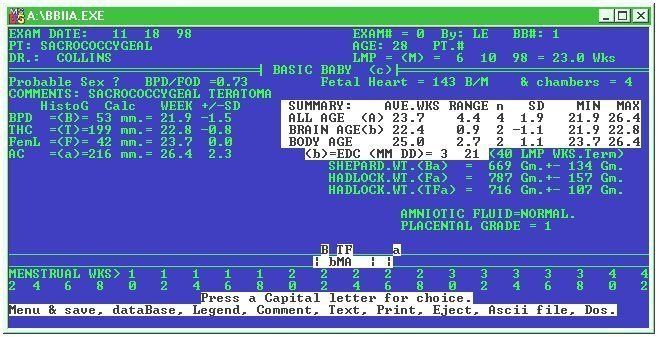Sacrococcygeal Teratoma
Sacrococcygeal teratoma ( SCT ) is the most common congenital neoplasm of the fetus. This tumor contains derivatives of more than one of the three embryonic germ cell layers and usually arises as a mass in the sacrococcygeal region.
Abstract: Sacrococcygeal teratoma ( SCT ) is the most common congenital neoplasm of the fetus. This tumor contains derivatives of more than one of the three embryonic germ cell layers and usually arises as a mass in the sacrococcygeal region. Fetuses with this malformation may have associated morbidity and mortality related to prematurity, dystocia, traumatic delivery and intratumoral hemorrhage. This case study demonstrates the accuracy of fetal sonography in the diagnosis of SCT.
Introduction: Teratomas are neoplasms which contain derivatives of more than one of the three primary germ cell layers of the embryo. Although these tumors are benign, one or more of the germ cell layer derivatives may develop malignant characteristics [12]. Teratomas usually arise as a mass in the sacrococcygeal region [7]. Though the exact etiology of most SCTs is unknown, the majority are thought to be sporadic. A few families with autosomal dominantly inherited presacral teratomas have been described in the literature, however. The recurrence risk for this family is probably not significantly above background [10].
Sacrococcygeal teratomas ( SCT ) are commonly very large ( average 8-10 cm ), well encapsulated and grossly lobulated. These masses possess both cystic and solid components. Sacrococcygeal teratomas are classified according to the degree of exterior component or intrapelvic extension: Type I tumors ( 46.7 per cent ) lie predominantly external to the normal body of the baby and have a minimal presacral component; Type II tumors ( 34.7 per cent ) present externally but have a significant intrapelvic extension. Type III tumors ( 8.8 per cent ) are apparent externally but lie predominantly within the pelvis and abdomen; and Type IV tumors ( 9.8 per cent ) are entirely presacral with no external presentation. Only 2 per cent of the SCT grow into the spinal canal [8, 12].
SCT is the most common congenital neoplasm of the fetus with an incidence of 1 in 40,000 births. About 80 per cent occur in girls, but it is more often malignant in boys. A substantial number have been encountered in twins. Most cases are asymptomatic in utero and diagnosed after birth. Fetuses with this malformation are at risk for significant perinatal morbidity and mortality [1, 3, 4, 7, 9]. "The prognosis depends on size and histology of the tumor, degree of prematurity, associated malformations, route of delivery and prompt and complete surgical removal...." [11]
According to the literature, the majority of fetuses died from their SCT, but not by the mechanism usually responsible for death in the postnatal series ( i.e., malignancy ). Instead, death apparently resulted from secondary effects of SCT. Tumor mass and associated polyhydramnios frequently caused pre-term labor and delivery; fetal survival depended on lung maturity. Massive hemorrhage into the tumor with secondary fetal exsanguination sometimes occurred spontaneously in utero or was precipitated by labor and delivery. Dystocia, secondary to tumor bulk or tumor rupture, some- times complicated delivery. Finally, in a few cases, placentomegaly and/or hydrops evolved, which, in turn, precipitated rapid fetal death [1, 2].

Please click on image for larger view.
Treatment of SCT is primarily surgical. Sacrococcygeal teratomas should be excised as soon as possible, because small, undifferentiated foci may proliferate and become aggressive. If diagnosed in utero, then intrauterine resection is recommended. Since the tumors are attached to the coccyx, the entire coccyx must be removed. Failure to remove the coccyx results in a 30 to 40 per cent risk of local recurrence [1, 12]. Congenital anomalies are often present in association with SCT, including genitourinary, anorectal and lower vertebral malformations [9].
Antenatal diagnosis of SCT is very important and increasingly being made with fetal sonography [6]. On ultrasound, SCT may be solid or mixed in echogenicity with interspersed or peripheral cystic components. The imaging of tumors which contain calcification varies in terms of increased echogenicity or echogenicity and shadowing [1, 7].
Case Report: This case was done at the University of Arkansas for Medical Sciences - Women’s Health Clinic. The examination was performed transabdominally with an Acuson 128 x P/10 with curved array 2.5 - 3.5 & 3.5 - 5.0 MHz transducers. The examination included a full evaluation of the fetus ( to assess fetal anatomy, size, position and state ), placenta, amniotic fluid and uterus as well as the cervix and lower uterine segment ( to look for evidence of cervical incompetence or placenta previa ).
The following case study demonstrates fetal sonography as an important tool in the diagnosis of SCT:
On November 18, 1998, a twenty eight year-old female with a 23 weeks gestation was referred for a level II ultrasound to work up possible myelomeningocele, microcephaly, and mass on the spine. The mother had no family history of birth defects.

Please click on image for larger view.
The sonographic examination revealed a single intrauterine pregnancy (IUP ) with an average gestational age of 23 weeks. The size was consistent with the last menstrual period (LMP). The study revealed a large mixed echogenic mass measuring 13 cm x 10 cm x 13 cm arising from the fetal sacrum and lower lumbar spine with possible invasion of the pelvis and abdomen; the characteristics were suggestive of SCT. No neural abnormalities were seen. The left kidney had ill-defined borders. The surrounding structures in the abdomen and pelvis showed increased density and heterogenicity suggestive of intraabdominal extension of the tumor. Severe hydramnios was also present. The diagnosis was then confirmed by MRI at the University of Arkansas for Medical Sciences.

Please click on image for larger view.
The mother received genetic counseling to stress the need for regular follow-up in the High Risk Pregnancy Clinic to asses for developing fetal hydrops. Counseling included discussion of the surgical procedure and long-term outcomes of this problem. In general terms, the counselor explained that surgery involved total tumor resection plus removal of the fetal coccyx in order to prevent recurrence. During this November 1998 counseling session, follow-up was scheduled for December 16, 1998; however, the mother did not keep this follow-up appointment. In February 1999 the referring physician reported that in November 1998, the mother had pre-term labor with delivery of a dead fetus. No additional information was available.

Please click on image for larger view.
Conclusion The sonographic findings are most consistent for sacrococcygeal teratoma. Fetuses with SCT are at risk for significant perinatal morbidity and mortality. Early detection is therefore important. In utero diagnosis by ultrasound offers new hope for improved management of SCT of the fetus. " ... Our recommendation is that all fetuses diagnosed with SCT undergo detailed sonographic evaluation to confirm the diagnosis, rule out associated anomalies, ... and assess placental size, type of SCT, and the presence or absence of hydrops ... " [2].
References:
Citation:
Chung, Eddins, Angtuaco, et al: "Sacrococcygeal Teratoma": May 1999, Ultrasound Secton OBGYN.net
References
1. Berman MC, et al. Obstetrics and Gynecology, 2nd ed. Lippincott-Raven Publishers. 1997; 16: 313-314.
2. Callen PW. Ultrasonography in Obstetrics and Gynecology, 3rd ed. W.B. Saunders Company. 1994; 26: 543-545.
3. Chisholm CA, et al. Prenatal diagnosis and perinatal management of fetal sacrococcygeal teratoma. American Journal of Perinatology. 15 ( 8 ): 503-5, 1998 Aug.
4. Garcia AM, et al. In utero decompression of a cystic grade IV sacrococcygeal teratoma. Fetal Diagnosis & Therapy. 13 ( 5 ): 305-8, 1998 Sep.-Oct.
5. Graf JL, et al. A surprising histological evolution of preterm sacrococcygeal teratoma. Journal of Pediatric Surgery. 33 ( 2 ): 177-9, 1998 Feb.
6. Holterman AX, et al. The natural history of sacrococcygeal teratoma diagnosed through routine obstetric sonogram: a single institution experience. Journal of Pediatric Surgery. 33 ( 6 ): 899-903, 1998 Jun.
7. Kawamura DM, et al. Abdomen and Superficial Structures, 2nd ed. Lippincott-Raven Publishers. 1997; 15: 532-533.
8. Putman CE, et al. Textbook of Diagnostic Imaging, 2nd ed. W.B. Saunders Company. 1994; 26: 316-318.
9. Rubin E, et al. Pathology, 3rd ed. Lippincott-Raven Publishers. 1999; 277.
10. Sanders RC et al. Structural Fetal Abnormalities: The Total Picture. Mosby. 1996; 4.9: 112-115.
11. Sergi C, et al. Huge fetal sacrococcygeal teratoma with a completely formed eye and intratumoral DNA ploidy heterogenicity. Pediatric & Developmental Pathology. 2 ( 1 ): 50-7, 1999 Jan.-Feb.
12. Taeusch HW, et al. Schaffer and Avery’s Diseases of the Newborn, 6th ed. W.B. Saunders Company. 1991; 116: 1042-1043.
Newsletter
Get the latest clinical updates, case studies, and expert commentary in obstetric and gynecologic care. Sign up now to stay informed.
S1E4: Dr. Kristina Adams-Waldorf: Pandemics, pathogens and perseverance
July 16th 2020This episode of Pap Talk by Contemporary OB/GYN features an interview with Dr. Kristina Adams-Waldorf, Professor in the Department of Obstetrics and Gynecology and Adjunct Professor in Global Health at the University of Washington (UW) School of Medicine in Seattle.
Listen
